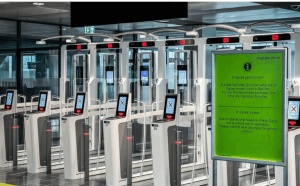
Starting Sunday, non-EU travelers entering Europe’s Schengen open-borders zone will be photographed and fingerprinted at border crossings, as the European Union (EU) rolls out its much-delayed automated border checks.
The new Entry/Exit System (EES) aims to eventually replace the manual stamp on passports and secure better information-sharing among the bloc’s 27 states. This system will allow authorities to accurately track entry and exit dates, with the goal of better detecting individuals overstaying their visas or those who have been previously refused entry.
Hotly debated for nearly a decade, the EES has raised concerns among transport providers and passengers, who fear it could lead to longer queues at airports and train stations. To limit disruptions, the system will undergo a phased rollout.
Phased Implementation
The first phase begins this Sunday. Non-EU nationals arriving for short stays in participating countries will be asked for their passport number, to provide fingerprints, and have their photo taken at automated kiosks. This applies to EU countries (except Cyprus and Ireland), as well as Iceland, Liechtenstein, Norway, and Switzerland.
To avoid huge queues at airports, the bloc’s biggest countries, including France and Germany, will initially carry out only limited checks. Some smaller member states, however, have the system fully operational from Sunday. All member states have until mid-April to implement automated checks for all passengers at their borders.
Impact on UK Nationals
All eyes will be on the UK border, as British nationals—no longer EU citizens after Brexit—will also be subject to the new checks. UK authorities have already warned Britons that each passenger should anticipate a few extra minutes of waiting before entering Schengen territory.
Operators like Getlink (Channel Tunnel) and Eurostar have expressed confidence in their readiness. Checks are being carried out for passengers in Britain before they cross the border, particularly at London’s St Pancras station and the port of Dover, where terminals have already been installed.
Future Plans: ETIAS
The EU executive confirmed that information campaigns will be launched to streamline the EES implementation, stating the system “will contribute to preventing irregular migration and help protect the security of everyone living in or travelling to Europe.”
The next phase in the EU’s border overhaul will be the launch of an electronic travel authorisation document, known as ETIAS (European Travel Information and Authorisation System). Similar to the United States’ ESTA, ETIAS will require citizens of visa-exempt countries travelling to the EU to complete an online form and pay a small fee, the amount of which is still under discussion.
Source: AFP
Share On:
CLICK HERE TO PROMOTE YOUR MUSIC/VIDEO
